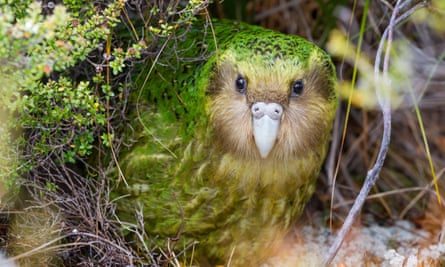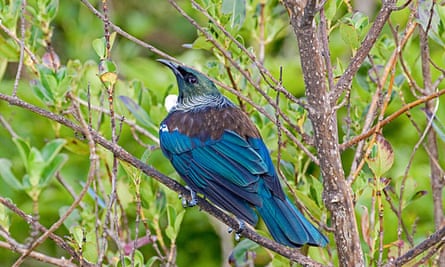From stealing parrots to drunken pigeons: why New Zealand is so obsessed with its native birds new zealand
When Miami Zoo ambassador Ron Magill woke up Tuesday, he could not have anticipated the storm of fury he was about to encounter.
A wave broke out as soon as he opened his inbox: hundreds of furious tweets, emails, videos, trending hashtags, TikTok. A 13,000-signature petition, headline news from every local media outlet, a formal government statement. As the day wore on, the uproar attracted the attention of New Zealand’s highest office – the prime minister weighed in at a press conference.
People outside Aotearoa may have been surprised to learn that the commotion was tied to a single bird, Paora the Kiwi. New Zealanders had felt that it was being handled by the public under bright lights – a treatment that was inappropriate for its reclusive, nocturnal nature. “We have offended a nation,” Magill declared, offering the zoo an apology and swiftly ending its kiwi encounter program.
The Paora incident will go down as one of the more recent examples of New Zealand’s ferocious love of its birds. “Hell hath no fury like the citizens of a country holding a ‘Bird of the Year’ competition – and the country internationally unusual for its feathered fauna,” quipped Auckland scientist Catherine Qualtrow. There is focus and dedication. That love has shaped its national identification and conservation agenda and launched a massive nationwide campaign to eradicate the animals that threaten avian populations.
“whyYou know what you know,” says Andrew Digby, a science adviser to the Department of Conservation – and what New Zealand does know is birds. The country is one of the few places worldwide with no native terrestrial mammals .
 The kiwi is considered a tonga (cultural treasure) by the Māori. Photograph: Oliver Strewe/Getty Images
The kiwi is considered a tonga (cultural treasure) by the Māori. Photograph: Oliver Strewe/Getty Images
The islands that now form New Zealand began to separate from other landmasses about 80 million years ago, when dinosaurs were still alive, and before mammals had become widespread. As a result, the country’s only endemic mammal species are seabirds such as bats and seals. 60m years ago, Aotearoa was completely isolated from other land bodies, and its bird populations evolved to fill the evolutionary niches typically filled by mammals.
As a result of that extraordinary ecological history, many of New Zealand’s birds are highly unusual, with distinctive features and unusual shapes. The kereru, a giant wood pigeon, has been known to eat fermented berries and fallen leaves from trees – sometimes in bird sanctuaries needing to pacify intoxicated birds. A large proportion are flightless land-dwellers, adapted to avoid aerial predators rather than as furry animals. The most famous is the kiwi—shy and flightless, with the proportions of a bowling ball—enough of a national icon that “kiwi” has become vernacular for New Zealanders.
But there are other symbols: the now-extinct giant moa, standing up to 3.6 m (12 ft) tall and weighing about 230 kg, was a wingless, grazing herbivore. Kea, mischievous, kleptomaniacal alpine dweller who attacks windscreen wipers, steals cameras and has learned to use tools. Kakapos, the world’s fattest parrots, are nocturnal, flightless and heavy, with a characteristic waddling gait. Kakapo behave more like a badger than a bird, says Digby: “An herbivore, the tree-climbing badger, fills that niche – they live in holes in the ground, come out at night, it a true mammalian characteristic”.
Māori culture regards many of those species as tonga – cultural treasures that should be respected and protected. And he is seen with great love and pride in the whole country.
Comedian Rebecca Shaw said, “One thing they don’t tell you is that New Zealanders love to talk about their birds.” “Every time I’m in a gathering of three or more people, they start talking about birds at some point.” The country elects a national bird every year, with strict voting rules and campaign teams for different candidates.
 The kakapo – a plump, flightless parrot – is the only species to reign as New Zealand’s bird of the year twice. Photograph: Nature Picture Library / Alamy
The kakapo – a plump, flightless parrot – is the only species to reign as New Zealand’s bird of the year twice. Photograph: Nature Picture Library / Alamy
“It’s a big part of our identity, isn’t it?” says New Zealand broadcaster Damian Christie, who now runs a neighborhood trapping group. “The birds were here before any of us. Birds are a part of our folklore, of Māori mythology – and then there’s the call. You can’t ignore that call in the morning.”
For millions of New Zealanders, the day begins with birdsong: either outside the window or on the radio, where every morning the national broadcaster introduces its AM news bulletins with a native bird call. Suggestions that “Birds” might be axed by the state network in 2005 were quickly dashed after an outcry from listeners – the radio said it had received 1,600 emails during the lunch hour, and a woman called her apartment A “Keep the Bird” banner unfurled from the window. Station Headquarters. For others, it’s the real morning chorus—one that’s growing louder after concerted efforts to establish predator-free urban sanctuaries and eliminate threats to native bird life.
AAs well as the unusual nature of the birds themselves, they are often shot prominently in order to preserve their welfare from the country’s unusual, sometimes experimental approach. Nigel, nicknamed “the lone gannet”, made international headlines after news spread that he had spent years dedicatedly trying to attract solid replica gannets to an isolated island off the coast of New Zealand. The solid birds were installed by conservation officers who hoped they would successfully attract and establish a gannet colony.
A more comprehensive strategy, however, is New Zealand’s massive effort to eradicate or at least dramatically reduce mammals such as rats, possums, stoats and hedgehogs, which pose a significant threat to native species, and go predator-free. To establish sanctuaries – islands or closed sections of the mainland – where birds can live unaccompanied.
 A tui on Tiritiri Matangi Island, New Zealand. Photograph: Rod Williams / Alamy
A tui on Tiritiri Matangi Island, New Zealand. Photograph: Rod Williams / Alamy
Christie is one of many New Zealanders who now have backyard trapping facilities in their neighbourhoods, supplying traps to around 100 households to catch and kill rats, stoats or other mammals that kill birds and their prey. eat eggs. “For me, it was about birdlife,” he says. “It’s about doing what you have to do to get those birds back into the city.”
The scope, scale and ambition of New Zealand’s conservation efforts is “quite unusual”, says Digby. “There’s a lot of work for the size of the country … There’s a lot of leading-edge work going on in conservation in New Zealand – it’s pushing the boundaries a bit because it has such an unusual set of circumstances.”
It is working in some places. In the capital city of Wellington, kiwis have been re-released in the hills, after huge efforts to free them from poachers. Once-rare native species such as the tui and kaka are being seen flying through the city again after establishing a population in an inner-city bird sanctuary.
“You’ll find kaka flying across the CBD, and people will notice those things – even people who don’t know conservation,” says Digby. “It is visible to all.”




